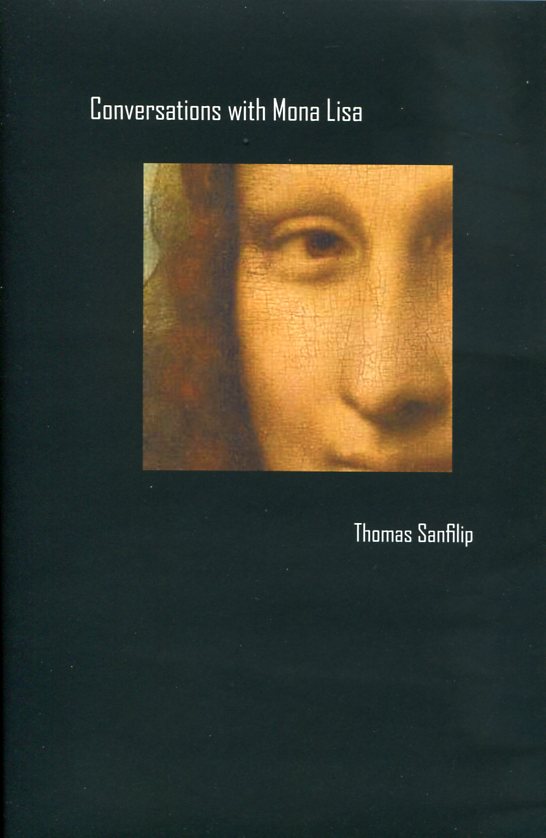
Conversations with Mona Lisa
Thomas Sanfiip
ISBN 978-0-991114-62-7
148 pages
Trade Hardcover
Price: $19.95
April, 2020
In Conversations with Mona Lisa Thomas Sanfilip melds poetry, philosophy and art into a unique literary work of brilliant prose often breathtaking in its beauty and aplomb, touching all three in a way that defies description. Sanfilip’s spiritual focal point is the Mona Lisa as the conduit through which the future of art, literature, poetry and culture is assessed with unerring perspective, at the same time, plunging into the very heart of cultural decay with uncompromising poetic courage. He reasserts the supremacy of poetic consciousness in the light of art and poetry’s end as cultural forces, challenging all those who refuse to recognize the spiral of death inundating the modern world in all its various forms. Philosophy and poetic prose, fragmented dreams and incomplete narratives shape Sanfilip’s distinctive work of philosophy and literature that moves the reader into the realm of pure symbolism laced with the poet’s intimate encounters with his own inner and outer world. As such, Conversations with Mona Lisa is not merely a collection of poetic prose and moribund insights, but a poet’s courageous attempt to refind a path back to the mythic voice of the psyche and its true sibylline roots.
The North Meridian Review
Reading Thomas Sanfilip’s Conversations with Mona Lisa is a bit like looking at a Marc Chagall painting: the pieces are dreamlike, often ethereal, yet tethered to everyday reality. Sanfilip’s volume of prose poems and poetry paint images and scenes that blur around the edges. The book is divided into untitled, numbered sections, and the prose poems within each section contain recurring images or settings. One section focuses on a hospital room where the speaker’s sister is close to death, while another section evokes a day spent at the seaside. Sanfilip wishes to capture poetic consciousness as the speaker moves through and bumps into the world. More than a few pieces are dedicated to surreal dream sequences where the speaker seems to have found human connection only to awake and have missed it. These fragmented poems capture consciousness at those moments when it pauses before rushing on to the next image; in doing so, the book attempts to mirror the human psyche in its wanderings.
An early piece invokes the eponymous Mona Lisa as muse. Sanfilip begins by establishing the setting: “The crowd pushes forward, the rapid fire of cameras clicking, flashes of light bouncing off the Plexiglas that shields the Mona Lisa from every conceivable assault of hot breath…yet under fire she remains poised and gazes out with all her enigmatic wiles intact, tranquil, calm, patient and eternal.” The speakers often resemble da Vinci’s subject: aloof and ever-present. They seem to be looking at the world through thick glass. He ends this same piece by directly addressing the woman at the center of the painting: “Help me find my way to your side where I can speak without fear and listening become one beyond the murder of your light, beyond the weight of your bones. Give me your last smile as the day wanes and the sky bursts in a flash of dying blue” (9).
For me, the most compelling pieces were those tethered to a grounded reality. In a prosaic vignette, the speaker visits a library giving away books that have not circulated in twenty years, and the speaker finds “a worn-out biography of Cezanne,” implying that it was once well loved and now obsolete. He next stumbles upon a book called The Pleasures of Antiquity, which prompts the speaker to “laugh at the irony of old books left rotting” (52). In one of the pieces set at the seashore, Sanfilip captures what it feels like to be at the beach, writing, “There are moments the air drops into absolute silence. The waves meekly run to shore without any noise. Even the drone of a small airplane is muffled… a stillness, coming and going as though something muting the energies” (81). His language here mirrors the sense of suspension that comes with sitting where water meets land.
The sense of suspension is also present in a powerful piece on a life-altering diagnosis of the speaker’s sister. Here he uses em dashes to show the way that time contracts and elongates at moments where the body waits to see what will become of it: “doctor questioning her – pressing her swollen abdomen – we study her chest x-ray from the back – enlarged heart I mistake for the left lung” (100). In this piece, as in the one on Mona Lisa, the speaker approaches enigmatic images and tries to discern meaning. In many ways, all of the pieces echo the questions that arise when he looks at Da Vinci’s masterpiece and the x-ray.
What is real? What can be counted upon? What slips away? These are the central questions of Sanfilip’s volume.
Denise Ryan, author of “Of Silken Waters”
Conversations with Mona Lisa is a trinity of mind, body and the thing that brings them together—art—the blueprint of our consciousness. Short aphorisms have tightly meshed into a visible consciousness, the reader somehow transported into the world of artistic expansion, like twilight, neither night nor day. The language is classical, full of beauty and drama. Beautiful prose poems balance the weight of philosophical thinking, giving the reader time to breathe, like mirrors into the mind of the writer. Cleansing and spiritual, Sanfilip’s intellect burns bright throughout, but in his prose poems the human side of the man shines in the darkness. Where does this book sit? In the poetry section, among the great philosophers, the art section? The beauty is it belongs among all three.
